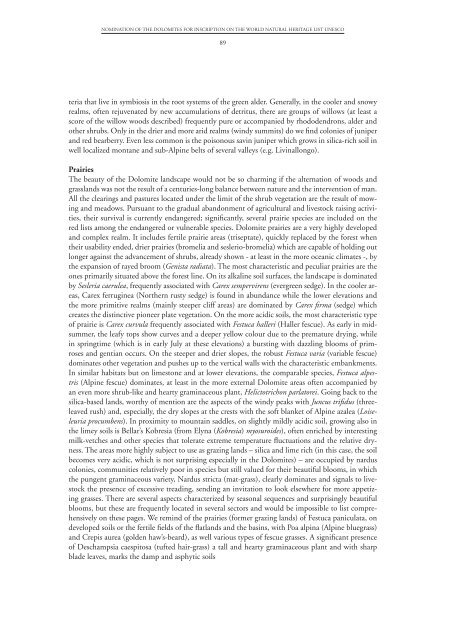DOLOMITES - Annexes 2-8 - Provincia di Udine
DOLOMITES - Annexes 2-8 - Provincia di Udine
DOLOMITES - Annexes 2-8 - Provincia di Udine
You also want an ePaper? Increase the reach of your titles
YUMPU automatically turns print PDFs into web optimized ePapers that Google loves.
NOMINATION OF THE <strong>DOLOMITES</strong> FOR INSCRIPTION ON THE WORLD NATURAL HERITAGE LIST UNESCO<br />
89<br />
teria that live in symbiosis in the root systems of the green alder. Generally, in the cooler and snowy<br />
realms, often rejuvenated by new accumulations of detritus, there are groups of willows (at least a<br />
score of the willow woods described) frequently pure or accompanied by rhododendrons, alder and<br />
other shrubs. Only in the drier and more arid realms (windy summits) do we find colonies of juniper<br />
and red bearberry. Even less common is the poisonous savin juniper which grows in silica-rich soil in<br />
well localized montane and sub-Alpine belts of several valleys (e.g. Livinallongo).<br />
Prairies<br />
The beauty of the Dolomite landscape would not be so charming if the alternation of woods and<br />
grasslands was not the result of a centuries-long balance between nature and the intervention of man.<br />
All the clearings and pastures located under the limit of the shrub vegetation are the result of mowing<br />
and meadows. Pursuant to the gradual abandonment of agricultural and livestock raising activities,<br />
their survival is currently endangered; significantly, several prairie species are included on the<br />
red lists among the endangered or vulnerable species. Dolomite prairies are a very highly developed<br />
and complex realm. It includes fertile prairie areas (triseptate), quickly replaced by the forest when<br />
their usability ended, drier prairies (bromelia and seslerio-bromelia) which are capable of hol<strong>di</strong>ng out<br />
longer against the advancement of shrubs, already shown - at least in the more oceanic climates -, by<br />
the expansion of rayed broom (Genista ra<strong>di</strong>ata). The most characteristic and peculiar prairies are the<br />
ones primarily situated above the forest line. On its alkaline soil surfaces, the landscape is dominated<br />
by Sesleria caerulea, frequently associated with Carex sempervirens (evergreen sedge). In the cooler areas,<br />
Carex ferruginea (Northern rusty sedge) is found in abundance while the lower elevations and<br />
the more primitive realms (mainly steeper cliff areas) are dominated by Carex firma (sedge) which<br />
creates the <strong>di</strong>stinctive pioneer plate vegetation. On the more aci<strong>di</strong>c soils, the most characteristic type<br />
of prairie is Carex curvula frequently associated with Festuca halleri (Haller fescue). As early in midsummer,<br />
the leafy tops show curves and a deeper yellow colour due to the premature drying, while<br />
in springtime (which is in early July at these elevations) a bursting with dazzling blooms of primroses<br />
and gentian occurs. On the steeper and drier slopes, the robust Festuca varia (variable fescue)<br />
dominates other vegetation and pushes up to the vertical walls with the characteristic embankments.<br />
In similar habitats but on limestone and at lower elevations, the comparable species, Festuca alpestris<br />
(Alpine fescue) dominates, at least in the more external Dolomite areas often accompanied by<br />
an even more shrub-like and hearty graminaceous plant, Helictotrichon parlatorei. Going back to the<br />
silica-based lands, worthy of mention are the aspects of the windy peaks with Juncus trifidus (threeleaved<br />
rush) and, especially, the dry slopes at the crests with the soft blanket of Alpine azalea (Loiseleuria<br />
procumbens). In proximity to mountain saddles, on slightly mildly aci<strong>di</strong>c soil, growing also in<br />
the limey soils is Bellar’s Kobresia (from Elyna (Kobresia) myosuroides), often enriched by interesting<br />
milk-vetches and other species that tolerate extreme temperature fluctuations and the relative dryness.<br />
The areas more highly subject to use as grazing lands – silica and lime rich (in this case, the soil<br />
becomes very aci<strong>di</strong>c, which is not surprising especially in the Dolomites) – are occupied by nardus<br />
colonies, communities relatively poor in species but still valued for their beautiful blooms, in which<br />
the pungent graminaceous variety, Nardus stricta (mat-grass), clearly dominates and signals to livestock<br />
the presence of excessive trea<strong>di</strong>ng, sen<strong>di</strong>ng an invitation to look elsewhere for more appetizing<br />
grasses. There are several aspects characterized by seasonal sequences and surprisingly beautiful<br />
blooms, but these are frequently located in several sectors and would be impossible to list comprehensively<br />
on these pages. We remind of the prairies (former grazing lands) of Festuca paniculata, on<br />
developed soils or the fertile fields of the flatlands and the basins, with Poa alpina (Alpine bluegrass)<br />
and Crepis aurea (golden haw’s-beard), as well various types of fescue grasses. A significant presence<br />
of Deschampsia caespitosa (tufted hair-grass) a tall and hearty graminaceous plant and with sharp<br />
blade leaves, marks the damp and asphytic soils

















